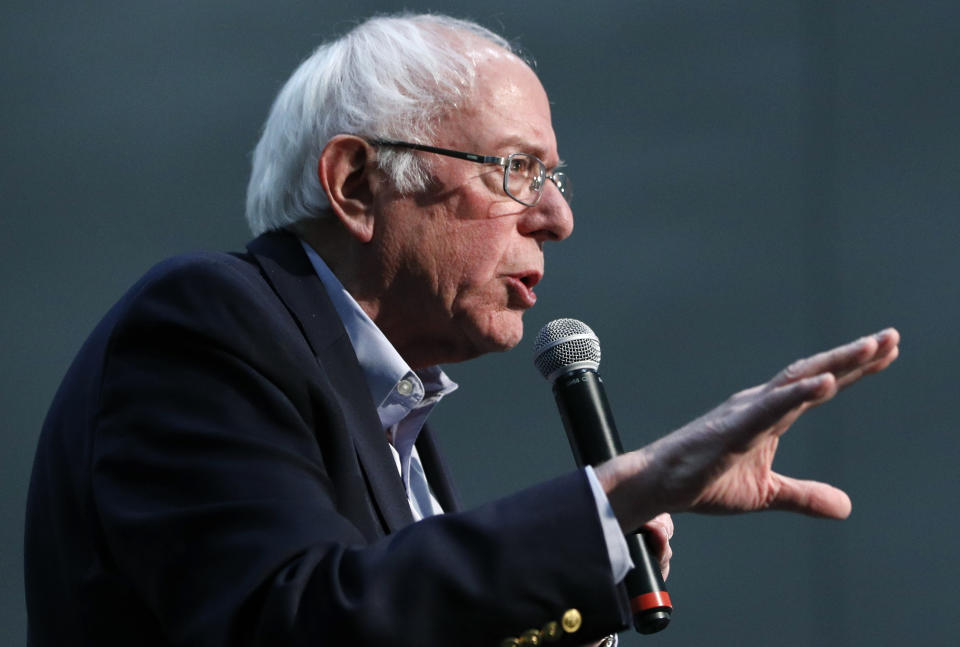Bernie Sanders 'Medicare for all' plan could shrink GDP by as much as 24%
According to analysis by the Penn Wharton Budget Model (PWBM), Medicare for all (M4A) could shrink U.S. GDP by as much as 24% by the year 2060, depending on how it is financed.
Despite this hit to economic growth, the plan proposed by presidential candidate Bernie Sanders (I-VT) isn’t without benefits. According to the analysis, Medicare for all would improve population health overall, increasing life expectancy by roughly two years, grow the population of the United States by 3%, and boost worker productivity. The share of the population that is “seriously ill” would also decline, from 15% to 13%.
But, the model warns, if the plan is deficit-financed — paid for by government borrowing — “the negative effects of larger deficits on labor supply, capital accumulation and GDP would significantly outweigh the positive effects on the economy that come from a larger and healthier workforce.”
Study author Kent Smetters told Yahoo Finance that if financing of Medicare for all were changed, the plan could “be something that increases GDP.”
Under current law, the analysis found, the uninsured population of the United States will increase from 10% to more than 27% by 2060. If Sanders’ Medicare for all plan were enacted, the uninsured rate of Americans would drop to zero.
With a healthier population, the study notes, Medicare for all would “improve longevity, worker health, and population size.” Depending on the financing of the plan, worker productivity and wages could also get a boost.
“M4A creates an immediate boost to wages and a broadening of the federal income tax base, resulting in higher federal tax revenues,” the report noted. “In the long run, however, this effect can be overtaken by economic effects of different financing options.”
Financing Medicare for all
According to studies, the cost of Medicare for all sits at roughly $32 trillion over the next decade. But, as the analysis notes, Sanders’ universal health care plan doesn’t have a built-in financing mechanism. The senator’s policy allows for different types of financing, including income-based premiums, savings on health care costs, and the wealth tax.
But as a previous Penn Wharton Budget Model found, Sanders’ wealth tax would generate $1 trillion less in revenue than he stated. The analysis of Medicare for all considers three different types of financing: premiums, payroll taxes, and deficit financing.
Under a premium model, everyone pays a flat rate regardless of age, income, or existing medical conditions. Payroll tax financing would be progressive, as a worker who has higher wages would pay a larger absolute amount. Lastly, deficit financing would rely on government borrowing, placing the costs of larger debt on current and future workers.

Premium-based funding. The PWBM finds that with premium financing, the U.S. economy could grow by 0.2% by 2060. Income tax revenue under this model increases by 16%, according to the analysis. Payroll tax revenues would be boosted by 26%. Worker productivity would also increase by 3.6% by 2060 compared to the current law.
Payroll-based funding. Medicare for all could also be paid for through payroll taxes. As a worker’s wages increase, the absolute amount paid for health care would also rise, making the tax progressive. Under this plan, GDP falls by 15%. While payroll tax revenues would grow by 160% under this model, income tax revenue would shrink by 6%.
Deficit-based funding. The real trouble comes when Medicare for all is financed by deficits. With government borrowing, universal health care could shrink the economy by as much as 24% by 2060, as investments in private capital are reduced. Worker productivity, however, would increase the most, at just under 8%. But overall income and payroll tax revenues would fall by 14% and 2%, respectively, after receiving a boost over the next two decades.
The report says “it would be a net positive for the economy if financed in a way that avoids increasing the debt or raising taxes and instead charges beneficiaries a premium designed to cover the program’s costs.”
Understandably, deficit financing would have a huge impact on the country’s debt levels. Using this type of financing would mean an increase in the federal debt by 92% by 2060, according to the Penn Wharton model. Currently, federal debt sits at over $23 trillion. Payroll tax financing would increase the deficit modestly, at 4%. With premium financing however, the federal deficit would shrink by 13%.
Other options
Sanders isn’t the only presidential candidate endorsing Medicare for all. Sen. Elizabeth Warren (D-MA) also supports the policy, though her plan would phase in universal health care, while Sanders aims to cover all Americans under M4A immediately.
Former Vice President Joe Biden and Mayor Pete Buttigieg have also put forth health care plans. Buttigieg’s plan, dubbed “Medicare for All who Want It” blends both a private and public option, allowing individuals to choose which plan they prefer. Biden similarly wants to allow for individual choice, and plans to build on Obamacare by adding a public option open to all Americans that is phased in gradually.
Kristin Myers is a reporter at Yahoo Finance. Follow her on Twitter.
Read more:
House bill to reshape credit reporting, help borrowers improve scores
Second Trump term would be ‘positive’ for economy and financial markets: report
Washington, D.C. sues Trump’s inaugural committee for abusing funds
Trump withholding aid to Ukraine illegal, says Government Accountability Office
New Trump housing rule to increase discrimination against minorities, say advocates
Read the latest financial and business news from Yahoo Finance
Follow Yahoo Finance on Twitter, Facebook, Instagram, Flipboard, LinkedIn, YouTube, and reddit.

 Yahoo Finance
Yahoo Finance 
